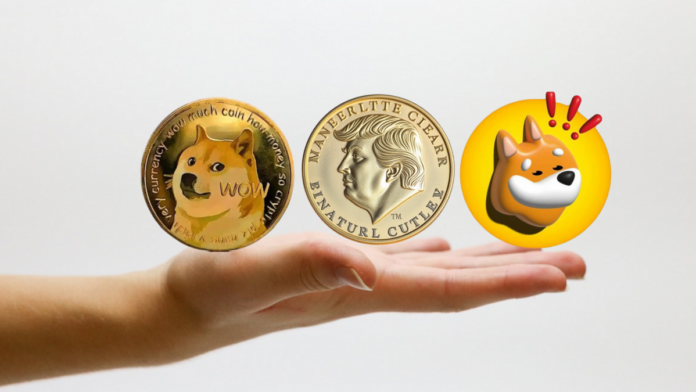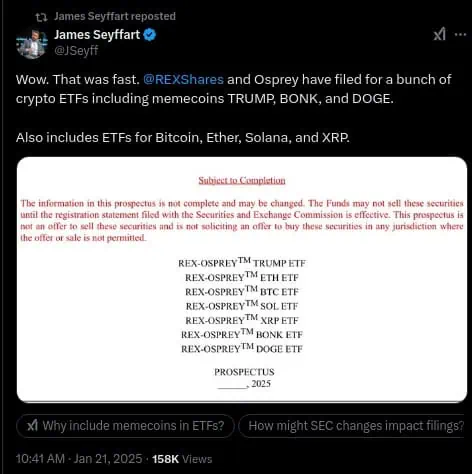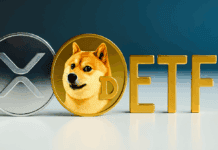
With Trump's second term beginning, ETF applications for memecoins and cryptocurrencies like Dogecoin, Bonk, and TRUMP have reached the SEC. Is the market ready for a new crypto investment landscape?
The US Securities and Exchange Commission (SEC) has received a new wave of applications for cryptocurrency exchange-traded funds in a move that reflects the growing influence of memecoins in the financial market.
Investment firms Osprey Funds and Rex Shares have filed applications with the federal agency to launch new ETFs based on cryptocurrencies such as Dogecoin, Bonk and the recently launched memecoin TRUMP. This fact coincides with the beginning of Donald Trump's second term as president of the United States, a political context that has generated great expectations about the future of crypto regulation.
The crypto ETF boom and the arrival of memecoins
The success of Bitcoin ETFs approved in 2024 marked a milestone in the cryptocurrency industry, opening the doors to a new wave of financial products. However, the novelty this time lies in the inclusion of memecoins, a type of cryptocurrency that, although it began as an internet joke, has gained a relevant place in the market.
Dogecoin, created in 2013 as a parody of Bitcoin, has managed to establish itself as one of the most popular cryptocurrencies, thanks in part to the support of figures such as Elon Musk. Meanwhile, Bonk, a memecoin based on the Solana network, has experienced exponential growth in recent months. And then there is TRUMP, the memecoin launched by the American president himself, which in just a few days reached a market capitalization of $15.000 billion.
ETF applications for these cryptocurrencies not only reflect their popularity, but also a change in perception among institutional investors, who seem willing to explore opportunities in assets that were previously considered too volatile or speculative.
Trump boosts cryptocurrency optimism
Donald Trump's second term, which began on January 20, 2025, is marked by expectations in the crypto world. During his election campaign, the Republican politician promised to promote a favorable environment for cryptocurrencies, including the creation of a national strategic Bitcoin reserve. These statements fueled a rally in the market, leading Bitcoin to surpass $100.000 for the first time in history, in November 2024.
However, on his first day in office, Trump did not mention cryptocurrencies in his speech nor did he sign any executive actions related to the sector. This created some uncertainty among investors, although many remain hopeful that the president will fulfill his promises in the coming months.
Against this backdrop, the memecoin ETF applications come at a key time. Firms Osprey Funds and Rex Shares submitted their proposals on the second day of Trump’s term, suggesting that market players are willing to test the limits of the new administration.
At the end of December, Nate Geraci, president of ETF Store, had questioned which companies would be the first to submit applications for the launch of a Dogecoin-based spot ETF.
What are these ETF applications?
The proposals filed with the SEC include seven exchange-traded funds that would track the performance of meme cryptocurrencies like Dogecoin, Bonk, and TRUMP, in addition to other major cryptocurrencies like XRP and Solana. According to the registration documents, these exchange-traded investment products would be structured under the Investment Company Act of 1940, a similar approach to that used in cryptocurrency futures ETFs.
Bloomberg ETF analyst James Seyffart noted that these proposals are “unique and novel” in their structure. The analyst commented in a post on X that “they will have a combination of derivatives, the assets and a subsidiary in Cayman that will hold the assets.”

Crypto Regulatory Challenges
While the introduction of these ETFs is a novelty, their approval will not be easy. The SEC has traditionally been wary of cryptocurrency-based products, and memecoins add an additional layer of complexity. TRUMP, for example, has only been around for a few days, making it difficult to assess its long-term stability and viability.
Furthermore, memecoins are known for their volatility and speculative nature. Dogecoin, for example, has seen extreme fluctuations in its price, which could raise concerns about investor protection, one of the SEC’s main targets.
However, despite the challenges, proponents of these proposals argue that ETFs could offer a safer, more regulated way for investors to participate in the memecoin market, attracting a broader audience and reducing some of the risks associated with direct cryptocurrency trading.
What does this mean for the crypto market?
The arrival of memecoin ETFs at the SEC represents an important milestone for the cryptocurrency industry. On the one hand, it reflects the maturity of the market, which has moved from being a niche for enthusiasts to an attractive space for institutional investors. On the other hand, it raises questions about the future of memecoins and their role in the financial ecosystem.
If the SEC approves these applications, it could open the door to a new wave of cryptocurrency-based financial products, including other memecoins and less conventional digital assets. This, in turn, could boost mass adoption of cryptocurrencies, although it could also increase risks for less experienced investors.
For now, these proposals only reflect the growing influence of memecoins in the market and the willingness of institutional players to explore new opportunities.
Although their approval is not guaranteed, it seems that memecoins are here to stay, and their impact on the financial market could be more significant than many imagine.



